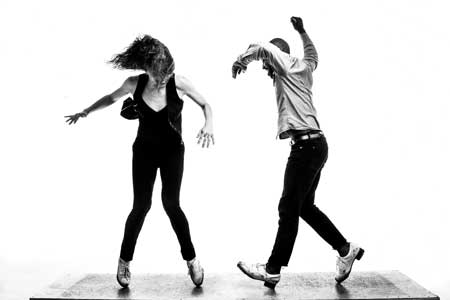Dance Performance
Dorrance Dance
Artistic Director: Michelle Dorrance
World Music/ CRASHArts
Cutler Majestic Theater
January 18-19, 2019
Three to One (2011)
Myelination (2017)
Dancers: Ephrat “Bounce” Asherie, Christopher Broughton, Elizabeth Burke, Warren Craft, Michelle Dorrance, Claudia Rahardjanoto, Leonardo Sandoval, Byron tittle, Matthew “Megawatt” West, Nicholas Van Young
Musicians: Donovan Dorrance, Aaron Marcellus, Gregory Richardson , Nicholas Van Young, Warren Craft

Byron Tittle
of “Dorrance Dance”
Photo: Matthew Murphy
Courtesy of Dorrance Dance and
World Music/ CRASHArts
If one goes to a typical Broadway musical and there are tap dance numbers, they are, no doubt, impressively coordinated, and as well, fairly predictable. Rhythms, though rapid, are probably not that complex overall, and though the coordination of the dancers itself can be noteworthy, the overall esthetic effect is likely to be more entertaining than inspiring.
But, in recent years, tap dancing has become an art form, and the capacity of those leading-edge choreographers who view it as such enable the creation of amalgamations of the truly entertaining aspects of tap with broader and newer visions of its possibilities.
Michelle Dorrance, the founder and artistic director of Dorrance Dance, has taken the form of tap and merged it with modern dance in service of this sort of vision. In the current program, she and her company offer two shorter investigations and a longer one along these lines.
Jungle Blues begins the program with a bluesy background and a sashaying set of moves that combine light tapping gestures with knee bending ones that almost, at times, suggest the Sixties dance made famous by Chubby Checker, “The Twist.” The piece is a relaxing and gesturally suggestive entrance into what follows. From the outset it is clear that this will be no ordinary tap dance recital, with slippings and slidings and bendings of the sort that one would not typically see in a conventional tap-dance context. At times the movements, almost of a gliding nature, give more of a sense of figure skating than of tap dancing.
Three To One unfolds with a woman tap dancer between two men who do not have tap shoes on and is an experiment in gestural contrasts. As the male non-tappers writhe and twist expressively, the female tapper carries on an energetic rhythm in between them, creating a sense of the rhythmic offset between moving feet and gyrating bodies. Long-lined melodies with penetrating vocals from the band provide a supple background upon which this subtly modest set of variations develop.
Myelination, the culminating piece, and by far the longest, ends the program with a robust series of routines by various subsets of the company, and by the entire company at points, in fully coordinated resplendency.
Many of the rhythms created by Dorrance’s innovative approach to stepping are syncopated, and unsettle, in a welcome way, what one typically expects from tap routines.
One is struck by the precision and the complexity of coordinating these aural as well as visual wonders which provide as much supplementation to the music as they do to the movement onstage. In some of these the feet fly so fast and with such unexpected alterations of form that one is amazed the dancers can carry them off together. They do, without a hitch, and the results are striking.
Myelination begins with a heartbeat from the musicians and continues, with its own biological inspirations, to generate what seem like a series of dance-reflections on what a complex network of synaptic enterprises a nervous system can be. (The term myelination, generally, refers to the growth of the outer protective coating of nerves.) In its series of inventions, this complex and engaging work invokes the sense of reactive energies gradually emerging into fully coordinated movement and into the neural anticipation of thought itself.
Scrapes, slips, falls, jumps, handstands, and, of course, amazingly deft flutterings of foot, ankle and leg, all interplay to form the groundwork upon which these pieces of rhythm are gradually built. The result is a wonderful patchwork of elements that render the sense of complexity of organic form. It is both a tribute to the jarringly astounding conceptual framework that enables such movement, and a celebratory evocation of it by artists who have employed it to create a wonderfully inspiring, technically striking, manifestations of its possibilities.
– BADMan
Leave a Reply